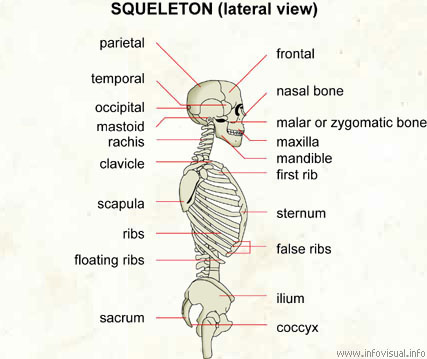Skeleton (lateral view)

Frontal: bone of the forehead.
Nasal bone: bones of the nose.
Malar or zygomatic bone: cheek bone.
Maxilla: bony upper part of the jaw.
Mandible: bony lower part of the jaw.
First rib: first bone of the thoracic cage.
Sternum: bone connected to the front of the ribs of the thoracic cage.
False ribs: the eight, ninth and tenth ribs of the thoracic cage, which protect the lower part of the lungs.
Ilium: bone of the pelvic girdle, comprised of the fusion of the ilium, the ischium and the pubic bone.
Coccyx: bone comprised of the fused, atrophied vertebrae at the end of the sacrum.
Sacrum: bone that is jointed with the hip bone to form the pelvis.
Floating ribs: last two ribs of the thoracic cage.
Ribs: bones forming the thoracic cage.
Scapula: bone of the back of the shoulder.
Clavicle: bone of the shoulder girdle, between the sternum and the scapula.
Rachis: spinal column.
Mastoid: protuberance behind the ear.
Occipital: bone forming the lower back part of the skull.
Temporal: bone of the temple.
Parietal: bones forming the sides and top of the skull.
Photo :

Domestic goats are one of the oldest domesticated species. For thousands of years, goats have been used for their milk, meat, hair, and skins all over the world. Most goats naturally have two horns, of various shapes and sizes depending on the breed. While horns are a predominantly male feature, some breeds of goats have horned females. Polled (hornless goats) are not uncommon and there have been incidents of polycerate goats (having as many as eight horns), although this is a genetic rarity thought to be inherited. Their horns are made of living bone surrounded by keratin and other proteins and are used for defense, dominance, and territoriality.
Goats are ruminants. They have a four-chambered stomach consisting of the rumen, the reticulum, the omasum, and the abomasum. Goats have horizontal slit-shaped pupils, an adaptation which increases peripheral depth perception. Because goats' irises are usually pale, the pupils are much more visible than in animals with horizontal pupils but very dark irises, such as sheep, cattle and most horses.
Both male and female goats have beards, and many types of goats may have wattles, one dangling from each side of the neck. Some breeds of sheep and goats appear superficially similar, but goat tails are short and point up, whereas sheep tails hang down and are usually longer, though some are short, and some long ones are docked.
Animation : The walking skeleton
Thanks to YouTube for allowing us to watch this video.
Objet virtuel : The walking skeleton
Thanks to YouTube for allowing us to watch this video.